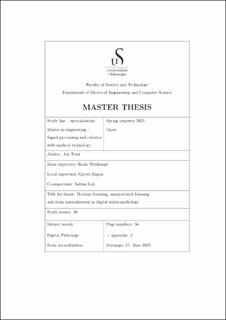| dc.contributor.advisor | Engan, Kjersti | |
| dc.contributor.advisor | Weishaupt, Hrafn | |
| dc.contributor.advisor | Leh, Sabine | |
| dc.contributor.author | Jon Tveit | |
| dc.date.accessioned | 2023-08-25T15:51:20Z | |
| dc.date.available | 2023-08-25T15:51:20Z | |
| dc.date.issued | 2023 | |
| dc.identifier | no.uis:inspera:129730556:69462956 | |
| dc.identifier.uri | https://hdl.handle.net/11250/3085855 | |
| dc.description.abstract | Chronic kidney disease is a serious health challenge and still, the field of
study lacks awareness and funding. Improving the efficiency of diagnosing
chronic disease is important. Machine learning can be used for various tasks
in order to make CKD diagnosis more efficient. If the disease is discovered
quickly it can be possible to reverse changes. In this project, we explore
techniques that can improve clustering of glomeruli images.
The current thesis evaluates the effects of applying stain normalization to
nephropathological data in order to improve unsupervised learning cluster-
ing. A unsupervised learning pipeline was implemented in order to evaluate
the effects of using stain normalization techniques with different reference
images. The stain normalization techniques that were implemented are:
Reinhard stain normalization, Macenko stain normalization and Structure
preserving color normalization. The evaluation of these methods was done
by measuring clustering results from the unsupervised learning pipeline,
using the Adjusted Rand Index metric. The results indicate that using
these techniques will increase the cluster agreement between results and
true labels for the data. Six reference images were used for each stain nor-
malization technique. The average Adjusted Rand Index score for all ref-
erence images was increased using all three stain normalization techniques.
The best performing method overall was the Reinhard stain normalization
technique. This method gave both the highest single experiment and aver-
age score. The other normalization methods both have one score close to
zero (unsuccessful clustering), and structure preserving color normalization
would outperform the Reinhard method if this single clustering was more
successful. | |
| dc.description.abstract | Chronic kidney disease is a serious health challenge and still, the field of
study lacks awareness and funding. Improving the efficiency of diagnosing
chronic disease is important. Machine learning can be used for various tasks
in order to make CKD diagnosis more efficient. If the disease is discovered
quickly it can be possible to reverse changes. In this project, we explore
techniques that can improve clustering of glomeruli images.
The current thesis evaluates the effects of applying stain normalization to
nephropathological data in order to improve unsupervised learning cluster-
ing. A unsupervised learning pipeline was implemented in order to evaluate
the effects of using stain normalization techniques with different reference
images. The stain normalization techniques that were implemented are:
Reinhard stain normalization, Macenko stain normalization and Structure
preserving color normalization. The evaluation of these methods was done
by measuring clustering results from the unsupervised learning pipeline,
using the Adjusted Rand Index metric. The results indicate that using
these techniques will increase the cluster agreement between results and
true labels for the data. Six reference images were used for each stain nor-
malization technique. The average Adjusted Rand Index score for all ref-
erence images was increased using all three stain normalization techniques.
The best performing method overall was the Reinhard stain normalization
technique. This method gave both the highest single experiment and aver-
age score. The other normalization methods both have one score close to
zero (unsuccessful clustering), and structure preserving color normalization
would outperform the Reinhard method if this single clustering was more
successful. | |
| dc.language | eng | |
| dc.publisher | uis | |
| dc.title | Machine learning, unsupervised learning and stain normalization in digital nephropathology | |
| dc.type | Master thesis | |
